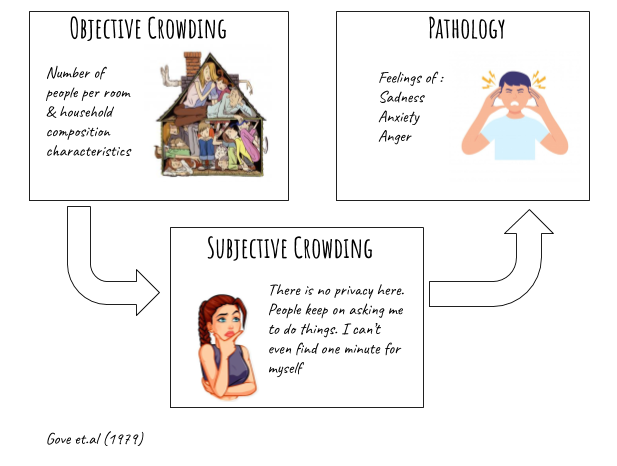
We all have a clear understanding of why practicing physical distancing is important during COVID-19 Pandemic. Nevertheless, it seems that we have not perceived the challenges that come along with it. One such challenge is the impact of our spatial settings while trying to maintain physical distancing i.e. Overcrowded or Isolated environmental settings and its effects on our mental health.
Many large families share a small living space with 10 individuals in 100square feet. This not only makes following precautionary self-isolation difficult but along with it comes a difficulty in finding personal space for oneself and increased social demands. There is a constant infringement of privacy in such settings which are elevated during such times when we cannot step out. One of the models proposed by Gove et.al (1979) helps us understand how the subjective experience of crowding can become pathological (below). Objective crowding means that the area one lives in is very densely populated (Number of People/Land Area) with small living spaces. But, whether one gets overwhelmed with their environmental conditions depends on person to person that is the subjective experience of crowding. Those who perceive it as a congested place often sense that it is impossible to have privacy and feel overburdened by the various social demands that they have to keep fulfilling. This creates a possibility for them to experience frustration and helplessness over their current living conditions leading them to experience more pathological states of anxiety and stress.
One valid fear is getting easily infected in such areas. A constant state of fear and anxiety can also lower one’s ability to function adequately.
On the other end of the continuum, there are individuals who live alone in 1000 square feet, having large living spaces but no one around. The precautionary measures are easy to follow, but it doesn’t rule out the possibility of difficulty in finding support at such crucial times. Moving out to seek some connection is ruled out during a pandemic, making it difficult to hold up their spirits. Again the subjective experience of isolation can lead to feelings of loneliness that affect both physical and mental health. Social neuroscientists John Cacippo (2007) has provided scientific evidence that persistent loneliness takes a toll on one's immune system and cardiovascular functions. Research suggests that prolonged feelings of loneliness can lead to a self-reinforcing cycle of negative thoughts, behaviors, and sensations(Cacioppo, J. T., Patrick, W., 2008) and also affects one’s mental health causing anxiety and paranoia (Cacioppo & Patrick, 2008). It is apparent that our judgment of isolation can lead to a downfall.
On the other end of the continuum, there are individuals who live alone in 1000 square feet, having large living spaces but no one around. The precautionary measures are easy to follow, but it doesn’t rule out the possibility of difficulty in finding support at such crucial times. Moving out to seek some connection is ruled out during a pandemic, making it difficult to hold up their spirits. Again the subjective experience of isolation can lead to feelings of loneliness that affect both physical and mental health. Social neuroscientists John Cacippo (2007) has provided scientific evidence that persistent loneliness takes a toll on one's immune system and cardiovascular functions. Research suggests that prolonged feelings of loneliness can lead to a self-reinforcing cycle of negative thoughts, behaviors, and sensations(Cacioppo, J. T., Patrick, W., 2008) and also affects one’s mental health causing anxiety and paranoia (Cacioppo & Patrick, 2008). It is apparent that our judgment of isolation can lead to a downfall.
Ways to Stay Mentally Healthy:
Shifting your perspective: The subjective experience of crowding/isolation can manifest in various negative outcomes. By just making a shift in your perspective you can elude from these known challenges. One of the strategies is by checking whether the thoughts running in your mind are 100% true or not. For eg: If you live alone, you may have thoughts like ‘ I am all alone. No one cares for me’, check if what you’re thinking holds validity or not, as many of our negative thoughts are biased in nature.
Extract what you can gain: Make the most of the situation and focus on what you can gain out of it, instead of concentrating on what you are losing. Make a list of gains that you have already achieved by living in such spaces.
Stay Positive: A positive attitude comes with a lot of benefits. Believe that no situation is going to last forever, and this too shall pass. Practicing gratitude by thinking about 3 things that you’re grateful for can help you stay positive.
Find a way to channel your feelings: Find a medium through which you can express how you’re feeling. It can be through virtual communication, journalizing, exercising, or getting creative.
Accept: Only after one accepts the reality can one move ahead, otherwise, one is stuck in the constant struggle of wishes v/s reality.
Puja Dedhia
Co-founder at ListenWorks
References:
Cacioppo, J. T. and Patrick, W. (2008) Loneliness: Human Nature and the Need for Social Connection New York: W. W. Norton and Company, p.7.
Cacioppo, J. T. and Hawkley, L. C. (August 2007) Aging and Loneliness: Downhill Quickly? Current Directions in Psychological Science http://psychology.uchicago.edu/people/faculty/cacioppo/CHASRS.shtml
Cacioppo and Patrick (2008) Loneliness (as in note 5).
Gove, W.R.; Hughes,. M. and Galle, O.R (1979). Overcrowding in the home: An empirical investigation of its possible pathological consequences. American Sociological Review Vol. 44 (Feb), 59-80.


Comments
Post a Comment